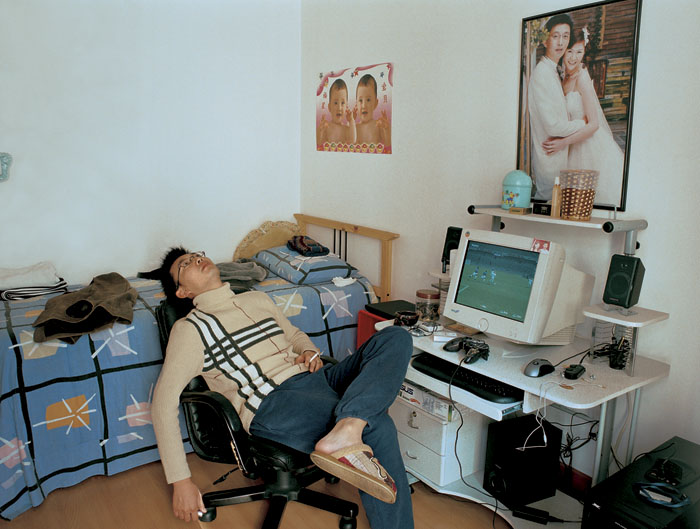 By reading Project 1, those of the audience should come away with a much greater understanding of the many intricate and compelling differences between American and Chinese photography. This will be realized by analyzing several pieces of Hu Yang's "Shanghai Longtang Exhibition" for his use of lighting, stylistic focus of people and objects, coloration (or often lack thereof), and his proposed vectors of attention, and juxtaposing these elements against a Western counterpart's thought of the art of photography. By analyzing the artist's work thus, viewers should come away with a better understanding of world culture and art, as well as to better grasp the degree to which the Western, and primarily American, schools of thought influence the rest of the globe.
By reading Project 1, those of the audience should come away with a much greater understanding of the many intricate and compelling differences between American and Chinese photography. This will be realized by analyzing several pieces of Hu Yang's "Shanghai Longtang Exhibition" for his use of lighting, stylistic focus of people and objects, coloration (or often lack thereof), and his proposed vectors of attention, and juxtaposing these elements against a Western counterpart's thought of the art of photography. By analyzing the artist's work thus, viewers should come away with a better understanding of world culture and art, as well as to better grasp the degree to which the Western, and primarily American, schools of thought influence the rest of the globe.The intended "readers" this blog is most focused upon pertain to Professor Ware and the rest of the English 151H class. Therefore, the work is intended for scholarly purposes, written to explore and apply the major rhetorical ideas within Compose, Design, Advocate. This being the case, the language which will be used will reflect this, in order to make these appeals most clear to the reader. Hopefully, through attempting to clarify the words of the text book by employing their message in a more tangible form, current and future peers of the writer will be better able to visualize not only the purpose of the class, but more importantly, the scintillating world of China through the eyes of one of their most prolific modern photographers.
By the same token, a greater audience will also be reached simply by the nature of the medium being used. As there are no limits upon this blog's readers, it must be understood that any netizen with a few minutes to spare may stumble upon this work and give it a good look-over. It is quite plausible that not every viewer of this paper will have a full grasp of the technical side of rhetorics and the methods applied to further such ideas as ethos, pathos, and logos. Therefore, the level of writing must also be somewhat blunt and remain in as much a conversational tone and language as possible. Keeping the blog written in these terms will not overcome the piece's needs in regards to being a class-based assignment, so the casual reader will take note of the author's sincerest apologies if and when the writing eludes their understanding. If this does not hold true for the majority of outside viewers, then this blog will have served both purposes of being a graded and scholarly work, as well as being an informative piece of digital literature.
At this point, the idea of what a blog is meant to be and the styles used in any online text have already been brought into question. The most widely-held, and somewhat stereotypical, definition for a blog encompasses a sole writer who speaks directly about their knowledge and opinions on one or a list of subjects, almost like a digital diary. With that in mind, I will take a quick step into a more personal, direct writing style. I am like many other readers of this page, a person who, after growing up in such a digital age, spends a vast majority of his time browsing the internet and using it for recreational, informative, and social purposes. Most of these users (I use the word netizen quite often for this group, as the regular follower has likely already noticed) do not intend for all of their posted writings to be scholarly by any stretch of the imagination, and thus we e
 mploy first-person, casual dialogs, writing to each other as we would speak and discuss the gossip of the day over a lunch table of friends. That is why I aim to keep this page's posts somewhat low-brow, in order to connect with as many readers as quickly as possible. That is not to say that netizens are any sort of uneducated people, by any means, so I am sure the vast majority of them will be more than happy to follow me in sagacious discussions of a vast many topics. Thus, I leave my audience with a picture which reflects this rounded view of our shared medium.
mploy first-person, casual dialogs, writing to each other as we would speak and discuss the gossip of the day over a lunch table of friends. That is why I aim to keep this page's posts somewhat low-brow, in order to connect with as many readers as quickly as possible. That is not to say that netizens are any sort of uneducated people, by any means, so I am sure the vast majority of them will be more than happy to follow me in sagacious discussions of a vast many topics. Thus, I leave my audience with a picture which reflects this rounded view of our shared medium.